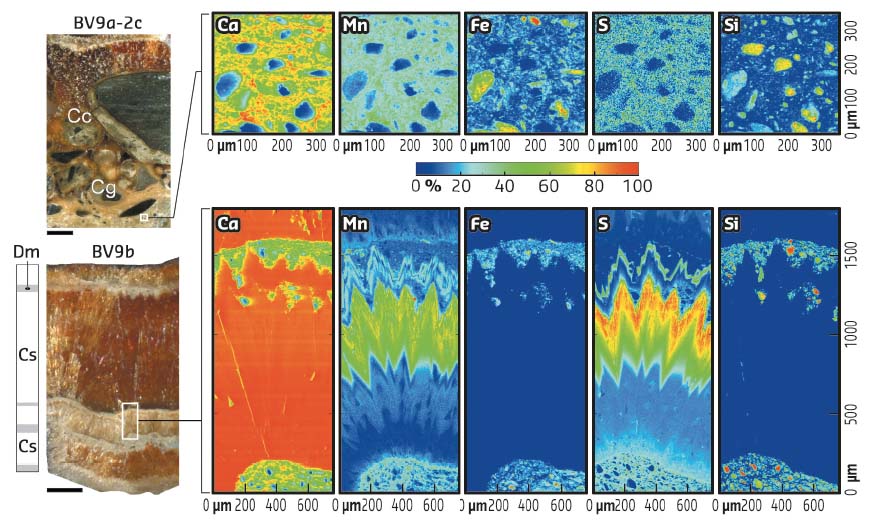- Home
- Users & Science
- Scientific Documentation
- ESRF Highlights
- ESRF Highlights 2017
- X-ray nanoprobe
- Antarctic subglacial volcanism, meltwater and the global C cycle
Antarctic subglacial volcanism, meltwater and the global C cycle
Antarctica hosts a large volcanic province, but many volcanoes are under the ice. Past subglacial eruptions go undetected by ice core records, yet they could have originated large bodies of subglacial meltwaters whose discharge influenced global climate. This research provides support to a link between magmatism, the Antarctic ice sheets and climate through synchrotron-based techniques.
It has been proposed that ancient eruptions caused significant melting of the ice sheets that covered Northern Europe at the end of the last Ice Age and influenced the global climate [1]. A link between volcanism and ice sheet melting would indicate a “positive feedback” in which eruptions exacerbate melting and more melting causes more eruptions [1]. The role of ancient subglacial volcanic activity in Antarctica was investigated by mapping trace elements in subglacial carbonates via synchrotron radiation-based micro X-ray fluorescence (SR-μXRF) and X-ray absorption near-edge spectrometry (XANES) at beamline ID21.
Subglacial calcites grew in pockets of meltwater at the base of Boggs Valley glacier (Northern Victoria Land, East Antarctic Ice Sheet) as a result of the combination of pressure-solution and geothermal energy from 26.951 ± 0.824 to 17.054 ± 0.332 ka. The ages coincide with the last glacial maximum (LGM), when ice thickness above the now deglaciated rocks was at least 700 m. These LGM subglacial calcites yielded DNA and petrographic evidence of hydrothermally influenced subglacial discharge, most likely from a lake, which invaded a subglacial polar oasis where water existed and microbes released micronutrients, such as divalent iron, from the bedrock.
SR-μXRF maps of double-polished, 300 mm-thick wafers of the calcites were acquired by using a monochromatic beam and a large solid-state detector. The excitation energy was set at 2.6 keV and 7.5 keV to maximize the XRF yield of sulfur, which marks volcanism, and iron respectively. The fluorescence signal of sulfur in the calcites is mostly yielded by sulfate, which is mostly concentrated in detritus-rich layers (Figure 77), where another volcanic-related element, fluorine, was previously detected. Both sulfate and fluorine are typical of Trans Antarctic Mountain volcanisms, most of which is known to occur subglacially. XANES spectra displayed a low intensity peak at 2473.3, attributable to amino acids (ref. cysteine), which supports the claim that DNA data come from microbial-related organic fragments embedded in the calcites. Critically, 47 % of the DNA found in the S-rich layers accounts for thermophilic microbial taxa belonging to phylogenetic groups that thrive at temperatures above 41°C.
 |
|
Fig. 77: SR-μXRF maps for the areas designated by a white box showing maximum concentration of S as sulfate and Fe, which is mostly present as oxy-hydroxides particulate. Scale bar for both samples is 5 mm. Elements are reported in normalised counts ranging from high (red) to low (blue) relative concentration according to the 0-100% scale bar. |
Other taxa are chemolithotrophs capable of releasing divalent Fe from pyrite oxidation. XANES spectra at the Fe-K edge revealed that most iron is trivalent and associated with the particulate illustrated in Figure 77. A small proportion is ferrous, which suggests bio-weathering at the ice-bedrock interface. Yet, both forms of Fe are potentially bioavailable, with the divalent Fe more so. If transported to the Southern Ocean, bioavailable Fe boosts phytoplankton bloom, thus contributing to C sequestration by organisms that, when they die, sink to the seafloor.
A high level of sulfate and fluorine occur in calcite layers whose ages cluster around 23,500 years. They indicate that a subglacial eruption melted the ice and formed a lake, which then discharged into Boggs Valley at, or just before, 23,500 years ago. The data suggest that Fe produced subglacially in Boggs Valley was transported to the ice-sheet margin by massive drainage of such a lake. This could have triggered a series of processes that, eventually, resulted in a positive feedback, inducing further cooling during peak glacial conditions. This is one of the first demonstrations of Antarctic volcanism exacerbating global processes.
Principal publication and authors
The influence of Antarctic subglacial volcanism on the global iron cycle during the Last Glacial Maximum, S. Frisia (a), L.S. Weyrich (b), J. Hellstrom (c), A. Borsato (a), N.R. Golledge (d,e), A.M. Anesio (f), P. Bajo (g), R.N. Drysdale (g,h), P.C. Augustinus (i), C. Rivard (j) and A. Cooper (b), Nat Commun. 8, 15425 (2017); doi: 10.1038/ncomms15425.
(a) School of Environmental and Life Sciences, University of Newcastle, (Australia)
(b) Australian Centre for Ancient DNA (ACAD), University of Adelaide (Australia)
(c) School of Earth Sciences, University of Melbourne, Parkville (Australia)
(d) Antarctic Research Centre, Victoria University of Wellington (New Zealand)
(e) GNS Science, Lower Hut (New Zealand)
(f) Bristol Glaciology Centre, School of Geographical Sciences, University of Bristol (UK)
(g) School of Geography, University of Melbourne, Parkville (Australia)
(h) Environnements, Dynamiques et Territoires de la Montagne, UMR CNRS, Université de Savoie-Mont Blanc, Le Bourget du Lac (France)
(i) School of Environment, University of Auckland (New Zealand)
(j) ESRF
References
[1] F. Muschitiello et al., Nat Commun. 8, 1020 (2017).



